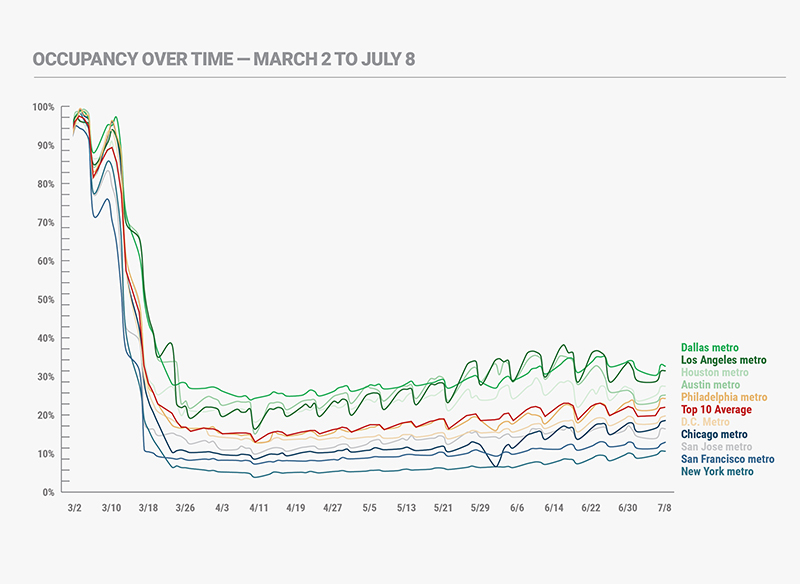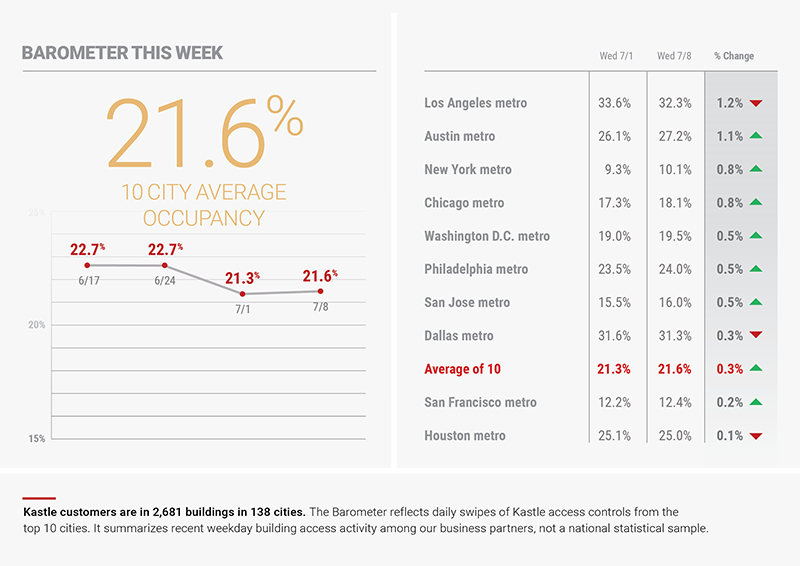Office Occupancy Varies as Virus Keeps Many Workers Home
In its latest weekly report, Kastle Access Control Data recorded declines in three U.S. metro areas where COVID-19 cases have surged again.
America’s office workers are slowly returning to offices, but parts of the U.S. where COVID-19 is surging are seeing a decline in office occupancy, according to the latest weekly occupancy report from Kastle Access Control System Data.
READ ALSO: Coworking Outlook Positive, JLL Finds
The Kastle Return to Work Barometer reported a slight uptick in occupancy last week, reaching 21.6 on July 8—based on the average of 10 metro areas—after bottoming out at 21.5 percent on July 1. The report covered metros for the following areas: Los Angeles, New York City, Chicago, Dallas, Washington, D.C., San Francisco, Houston, Philadelphia, San Jose, Calif., and Austin, Texas. Beginning in late May, occupancy started to inch up in Austin, Houston and other Texas cities. But last week, when Texas was among several U.S. cities that saw a resurgence of coronavirus cases, the metros saw a decline in office occupancy. Last week, Los Angeles, Dallas and Houston were the only metros on the list that saw declines. Houston saw the sharpest decline, falling 6 percentage points in a single week. The average of the 10 metros for last week was a 0.3 percent increase. Only Philadelphia has had steady improvement during the past two weeks.
“As expected, office occupancy patterns are responding to the trends we’re seeing nationwide with COVID cases. Areas that are seeing surges in cases are slowing their return to the office, while areas where cases remain stable are experiencing small increases in office occupancy,” CEO Haniel Lynn told Commercial Property Executive. “We expect that as this pandemic continues, buildings and office spaces will need to think harder about what measures they will need to take to ensure worker health and safety.”
Behind the numbers
The Barometer is an average based on millions of aggregated, anonymous daily building access data points from Kastle-secured properties. To compile it, Kastle Systems uses keycard, key fob and KastlePresence app access data from the 3,600 buildings and 41,000 businesses the company secures across 47 states.
On July 8, the Barometer for the 10 metros in the report showed: Los Angeles, 32.3 percent, down 1.2 percent; Austin, 27.2 percent, up 1.1 percent; New York City, 10.1 percent, up 0.8 percent; Chicago, 18.1 percent, up 0.8 percent; Washington, D.C., 19.5 percent, up 0.5 percent; Philadelphia, 24.0 percent, up 0.5 percent; San Jose, 16.0 percent, up 0.5 percent; Dallas, 31.3 percent, down 0.3 percent; San Francisco, 12.4 percent, up 0.2 percent and Houston, 25.0, down 0.1 percent.










You must be logged in to post a comment.